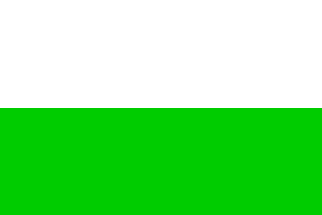
Last modified: 2005-10-08 by zeljko heimer
Keywords: burundi | political | parti de l’unité et du progrès national du burundi | unite | front | frodebu | palipehutu | hutu | tutsi | twa | batwa |
Links: FOTW homepage |
search |
disclaimer and copyright |
write us |
mirrors

On p.99 of [cra89a],
the flag is described as «diagonal white over red».
Randy Young, 18 Jan 1999
I can confirm now the Tutsi flag of the then ruling party UPRONA (led by
Colonel Bagaza), that is white and red diagonally divided.
Source: Jeune Afrique 1126, dated 4-8-82, reported by P. Bissuel from Guer in
Flaggenmitteilung [fml] nr. 84.
Jaume Ollé, 29 July 2001

.jpg)
The official website of Uprona (www.partiuprona.org) gives the name of the party as:
Parti de l'Unité pour le Progrès National (Unity Party
for National Progress). Moreover, it shows two crossed flags, the UPRONA flag above corssed with the flag of Unité.
This would mean that Unité and UPRONA have merged, which might explain the change in the full name of UPRONA.
UPRONA is indeed one of the oldest political parties in Burundi. It
was founded in 1959 as the Union pour le Progrès National by
Prince Louis Rwagasore, the son of the King of Burundi. Most of his
members were Tutsis. In 1960, the Belgian colonial administration
supported the other parties, and UPRONA lost the municipal election. On
18 September 1961, UPRONA won the general election supervised by the
United Nations. In October 1961, Rwagasore was murdered.
In 1966, a one-party system was established and UPRONA was the main
tool of control of the Hutu population. Colonel Bagaza ruled Burundi
with the help of UPRONA from November 1976 to September 1987. UPRONA
was restructured in 1991. (Source: Encyclopaedia Universalis)
The white and red flag of UPRONA is also shown on the emblem of the
party.
Ivan Sache, 20 February 2005

During its first national extraordinary congress, held on 19 and 20
October 2002 in Bujumbura, the Front pour la Democratie au Burundi
adopted its statutes:
"Title 1. General provisions
Chapter 1. Of the name and headquarters
Article 1.
It is constituted in Burundi a political party for the struggle and
consolidation of democracy named Front pour la Démocratie au
Burundi, with the abbreviated name Parti Sahwanya Frodebu.
Article 2.
The militants of the Parti Sahwanya Frodebu are called Inziraguhemuka.
Article 3.
The motto of the Parti Sahwanya Frodebu is: Democracy, Work, Equity.
Article 4.
The colours of the Parti Sahwanya Frodebu are green, symbol of hope, and white, symbol of peace."
The frontpage of the party website shows the flag of the party, along
with the national flag of Burundi.
The flag of the Parti Sahwanya Frodebu is horizontally divided white-green.
Source: http://www.frodebu.bi/index.htm Party website
Since FRODEBU is the main opponent to UPRONA, it is not surprising that it uses the white and green colours of the national flag, whereas UPRONA uses the white and red colours of the national flag.
Ivan Sache, 20 February 2005
The Parti pour la Liberation du Peuple Hutu du Burundi (PALIPEHUTU) adopted its revamped statutes during its national congress, hold on 18 August 1991.:
Article 2.
The emblem of the PALIPEHUTU is made of a bent bow and an arrow placed between a hoe and a hammer.
Article 3.
The flag of the PALIPEHUTU is red with in its center a green circle in which is inscribed the emblem of the party in black colour. Red symbolizes the suffering endured by the people of Burundi. The bent bow and the arrow symbolize the struggle for the fundamental rights and liberties.
The hoe and the hammer, whose handles converges, symbolize the commitment in unity to agricultural and industrial development, respectively. Green symbolizes the hope to set up peace, justice and democracy in our country.
Source: http://www.chez.com/academiehu/statut.htm Party website
Ivan Sache, 20 February 2005